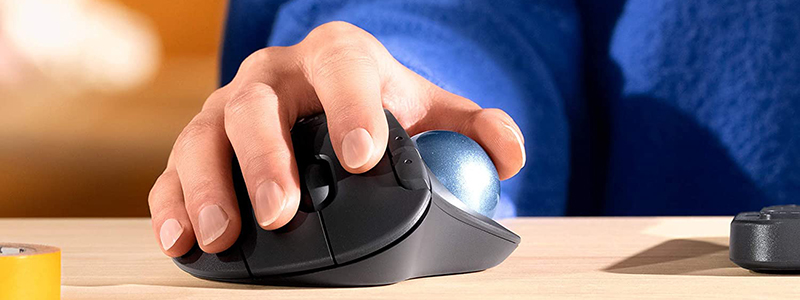
Dust particles can pour into your trackball or mouse and accumulate over time, just like they can on any other electrical equipment. The longer you use your trackball without cleaning it, the more likely you will have issues with your sensor’s tracking ability.
This article will show you how to clean a trackball mouse in just a few minutes thoroughly. Your trackball mouse does not need to be completely dismantled or disassembled because it can be done quickly, efficiently, and safely.
Recommended Tools For Cleaning Your Trackball
- Microfiber – used to clean the plastic surfaces.
- Q-tips – for cleaning bearings and other difficult-to-reach places
- Air Sweeper – to clear dust from the sensor and housing
- A brush – to clean the joints and tiny crevices.
- Tiny screwdriver (optional) – to access the trackball and clean it thoroughly.
- Tweezers (optional) – to aid in the removal of stickers and the disconnection of ribbon cables. Take the toothpick and glass cleaner as well.
Now that we have all we require. Let’s begin the cleaning.
Note: Before you begin, make sure your trackball is switched off or disconnected and the batteries have been removed.
Pre-Clean Wipedown
Get your microfiber cloth and wipe off the surfaces of your mouse if your trackball hasn’t been cleaned in a while. Make sure your towel is just a little moist, and not completely saturated.
If you’re going to use a disinfectant spray, make sure it’s okay for plastic and spray the towel instead of the trackball.
Cleaning the Trackball
If the ball is sticky or extremely greasy, cleaning the ball and everything in the housing cup underneath it is an excellent idea.
Step 01: Pop-out Trackball
Based on the trackball, this might require popping the ball out via the access hole with a pen or finger or just tipping your gadget upside-down & allowing gravity to do the job.
There may even be a stylish eject button on some newer models. Whatever method you choose, make sure your trackball is loose and out.
Step 02: Wipe Down With Wet Microfiber
Take your microfiber cloth and wipe off the ball if it’s extremely sticky or oily now that we’re free-balling.
While the oils on your skin and fingertips aid in the smooth rolling of the ball, too much attract dust and filth. A microfiber cloth, moist or dry, will assist wipe anything off the surface.
Cleaning the buttons is a little more difficult since you risk damaging them if you don’t do it correctly.
So, to do this correctly, unplug your mouse from the equipment and carefully wipe any dust particles or dirt and grime. It may have piled up inside the corners surrounding the buttons that it might otherwise not be possible to access.
Next, disinfect the buttons with rubbing alcohol and remove any lubricant or dust that has developed over time.
How To Clean Bearings and Sensor
Three roller bearings, as well as a sensor, may be found in the socket cup under your trackball.
The bearings may accumulate a lot of dust, filth, grease, oil, and anything else that finds its way beneath the trackball over time, especially in dustier conditions.
To retain a smooth trackball, it’s critical to wipe down these areas on a routine basis.
1. Clean the Bearings and Sensor
Clean out any filth on top of the bearings with a Q-tip, tiny brush, or the similar microfiber as previously.
Because some bearings roll while others don’t, you may need to use a brush or toothpick to wipe down both the bearing as well as the housing if other techniques fail to reach the nooks and crannies.
If you have an air duster, use this to sweep aside any particles that have found their way into the sensor cavity. Not only should your balls ride on clear bearings, but the sensor should be able to sense the ball properly as well.
Start giving the cup a final wipedown with your microfiber before replacing the trackball in its housing.
Deep Cleaning
It is important to remember that if your warranty hasn’t already gone, this will most certainly void it, so continue around your own risk.
- Remove the rubber feet and stickers from your trackball.
- Open up your mouse by loosening and removing all screws with a small screwdriver, most likely a Philips head #1. Photograph everything so you can see how the puzzle pieces go back together.Disassemble the components with care, being cautious not to break any wire connectors or small parts.Now is the moment to dust and wipe down the trackball mouse’s interior.After all this, it’s time to put everything back where it belongs.
Measures to Take While Cleaning Trackball Mouse
You must not allow the hardware inside of the trackball mouse to become wet while cleaning it. To clean each part, just use rubbing alcohol or water, and make sure the cloth is not soaked with these fluids.
Cleaning your trackball mouse on a routine basis is also necessary. It will become more accurate and efficient as you clean it. The timeline varies, but if you clean the trackball once every six months, it will work at full capacity.
Conclusion
Mouse, gaming or otherwise, get filthy, and a trackball mouse is not an exception.
It’s crucial to have a clean mouse not only for hygienic reasons but also for performance, comfort, and mouse longevity. It would be best if you also had a clean mouse-pad to prevent the trackball mouse from dust.
